Corporate Governance & Strategy: Legal Implications
VerifiedAdded on 2020/07/22
|16
|4361
|83
AI Summary
This assignment explores the intersection of law and business strategy, focusing on corporate governance, strategic contracting, and alternative dispute resolution. Students will analyze real-time messaging conversations, proxy access rules, and bribery laws using a mix of academic sources such as Bagley (2010), DiMatteo (2010), and Nichols (2012). The assignment also touches upon organizational behavior and the business case for compliance with bribery laws.
Contribute Materials
Your contribution can guide someone’s learning journey. Share your
documents today.
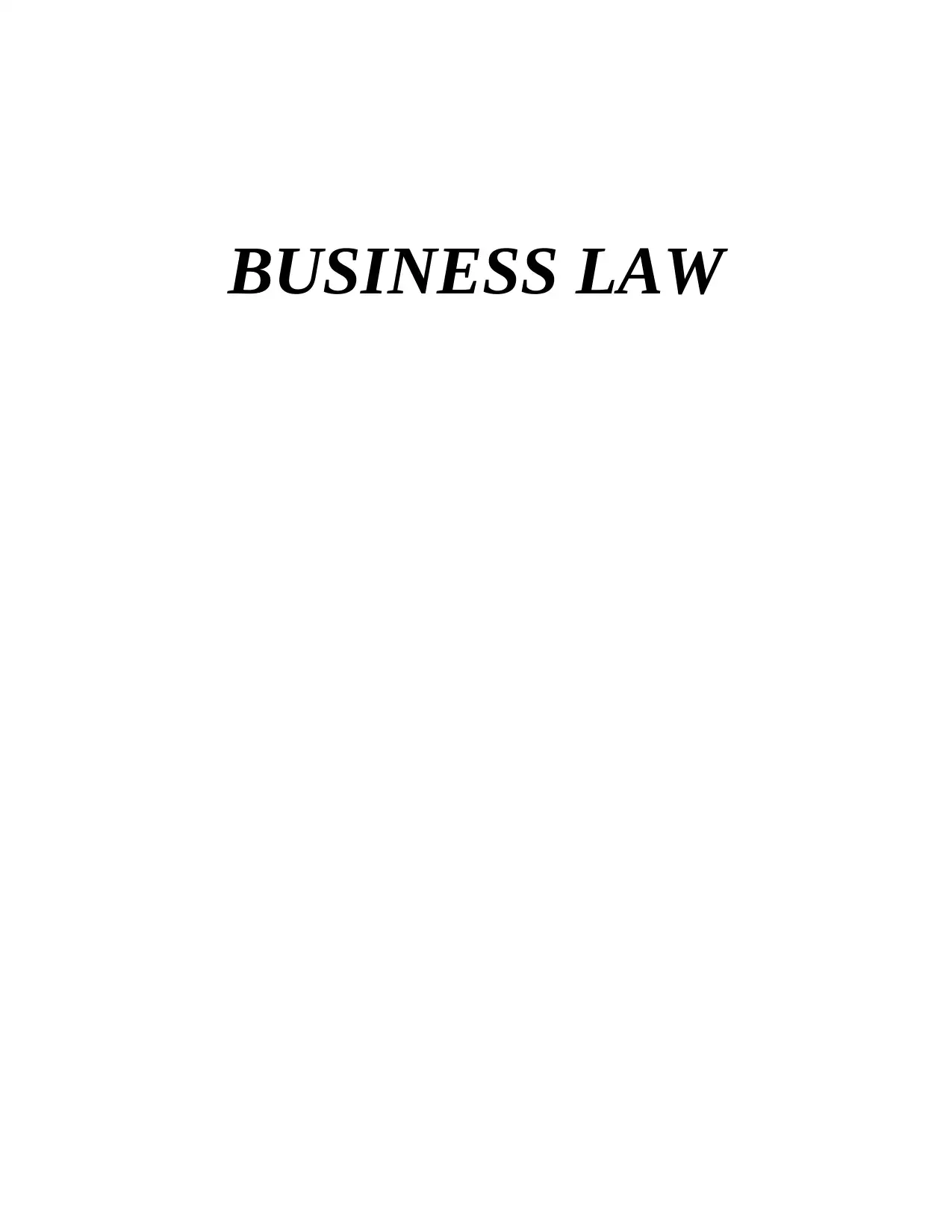
BUSINESS LAW
Secure Best Marks with AI Grader
Need help grading? Try our AI Grader for instant feedback on your assignments.
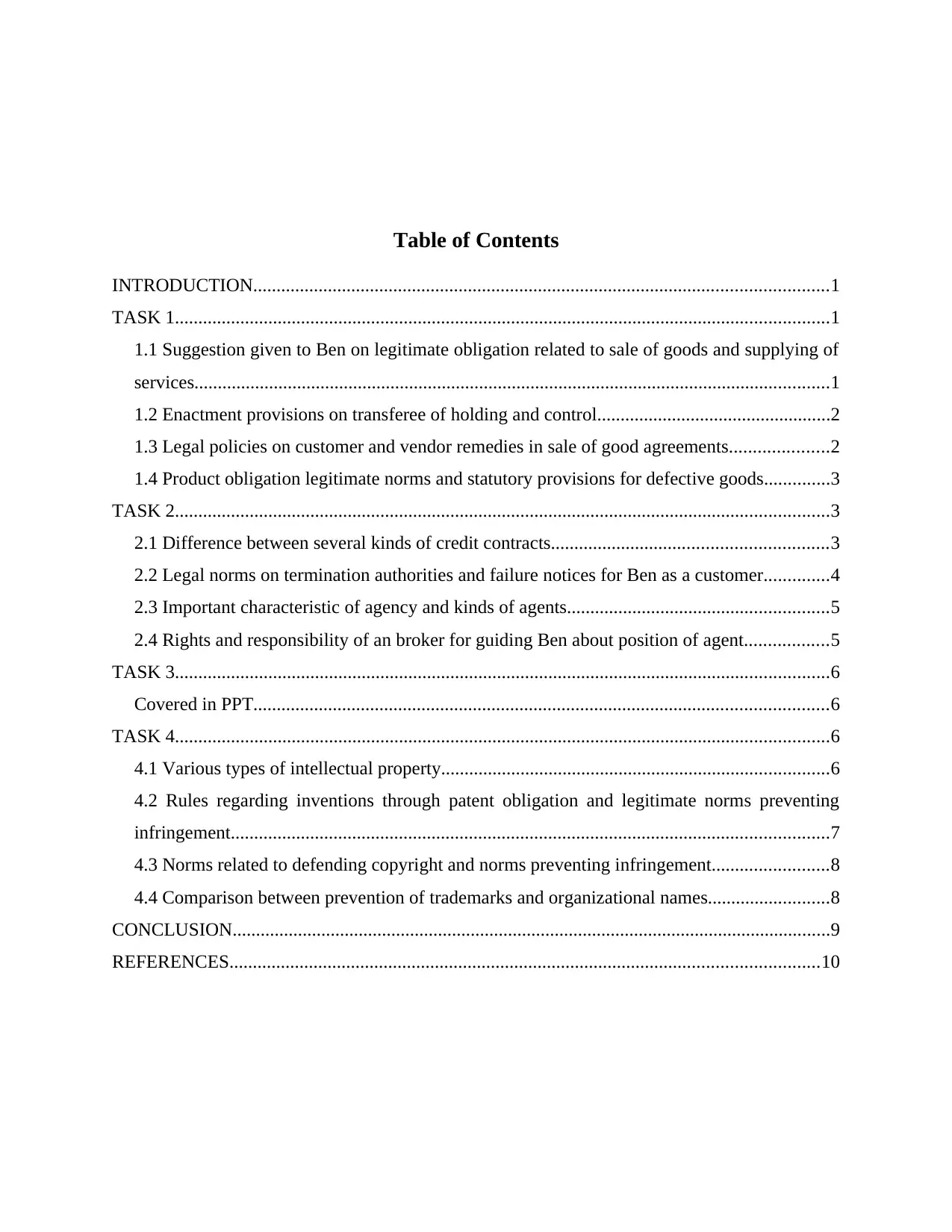
Table of Contents
INTRODUCTION...........................................................................................................................1
TASK 1............................................................................................................................................1
1.1 Suggestion given to Ben on legitimate obligation related to sale of goods and supplying of
services........................................................................................................................................1
1.2 Enactment provisions on transferee of holding and control..................................................2
1.3 Legal policies on customer and vendor remedies in sale of good agreements.....................2
1.4 Product obligation legitimate norms and statutory provisions for defective goods..............3
TASK 2............................................................................................................................................3
2.1 Difference between several kinds of credit contracts...........................................................3
2.2 Legal norms on termination authorities and failure notices for Ben as a customer..............4
2.3 Important characteristic of agency and kinds of agents........................................................5
2.4 Rights and responsibility of an broker for guiding Ben about position of agent..................5
TASK 3............................................................................................................................................6
Covered in PPT...........................................................................................................................6
TASK 4............................................................................................................................................6
4.1 Various types of intellectual property...................................................................................6
4.2 Rules regarding inventions through patent obligation and legitimate norms preventing
infringement................................................................................................................................7
4.3 Norms related to defending copyright and norms preventing infringement.........................8
4.4 Comparison between prevention of trademarks and organizational names..........................8
CONCLUSION................................................................................................................................9
REFERENCES..............................................................................................................................10
INTRODUCTION...........................................................................................................................1
TASK 1............................................................................................................................................1
1.1 Suggestion given to Ben on legitimate obligation related to sale of goods and supplying of
services........................................................................................................................................1
1.2 Enactment provisions on transferee of holding and control..................................................2
1.3 Legal policies on customer and vendor remedies in sale of good agreements.....................2
1.4 Product obligation legitimate norms and statutory provisions for defective goods..............3
TASK 2............................................................................................................................................3
2.1 Difference between several kinds of credit contracts...........................................................3
2.2 Legal norms on termination authorities and failure notices for Ben as a customer..............4
2.3 Important characteristic of agency and kinds of agents........................................................5
2.4 Rights and responsibility of an broker for guiding Ben about position of agent..................5
TASK 3............................................................................................................................................6
Covered in PPT...........................................................................................................................6
TASK 4............................................................................................................................................6
4.1 Various types of intellectual property...................................................................................6
4.2 Rules regarding inventions through patent obligation and legitimate norms preventing
infringement................................................................................................................................7
4.3 Norms related to defending copyright and norms preventing infringement.........................8
4.4 Comparison between prevention of trademarks and organizational names..........................8
CONCLUSION................................................................................................................................9
REFERENCES..............................................................................................................................10
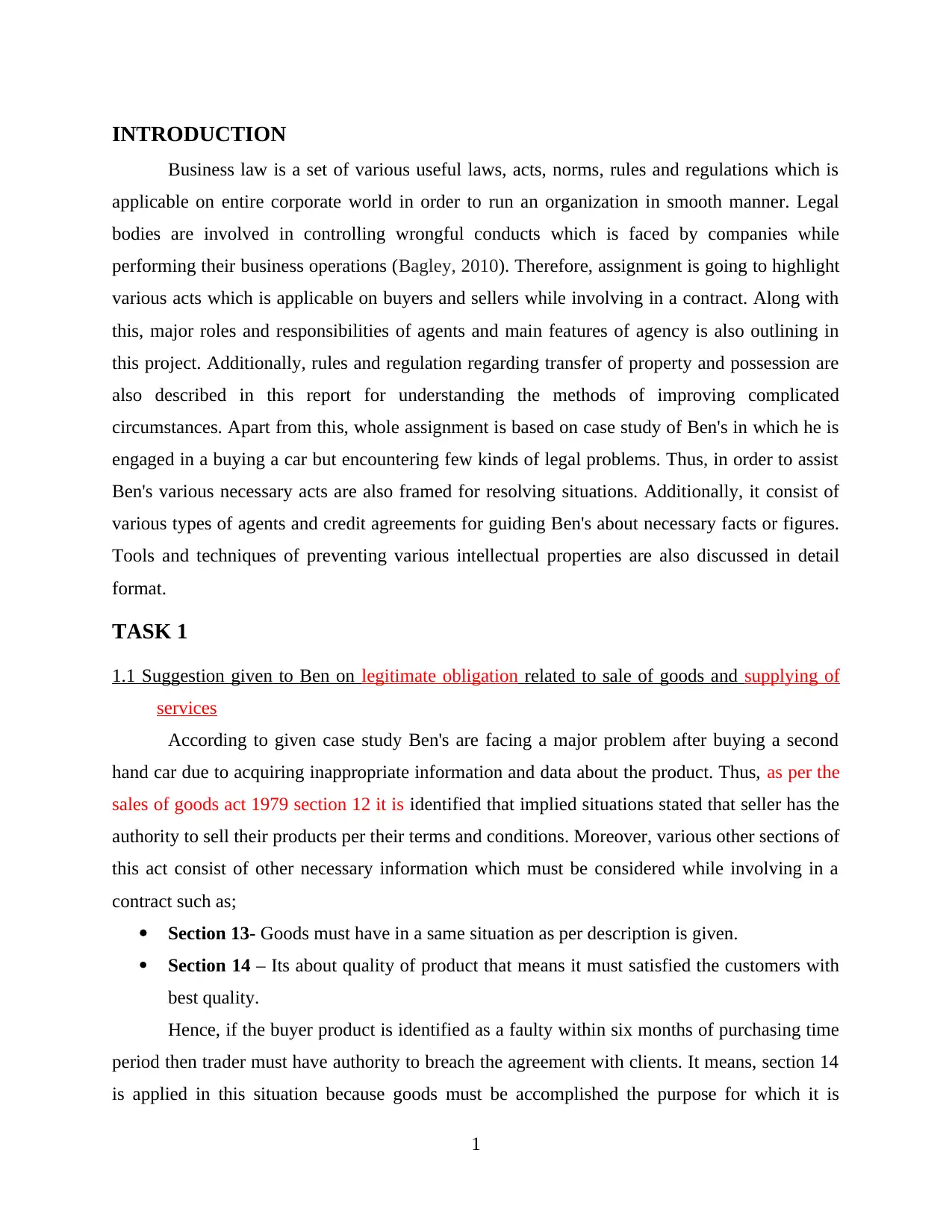
INTRODUCTION
Business law is a set of various useful laws, acts, norms, rules and regulations which is
applicable on entire corporate world in order to run an organization in smooth manner. Legal
bodies are involved in controlling wrongful conducts which is faced by companies while
performing their business operations (Bagley, 2010). Therefore, assignment is going to highlight
various acts which is applicable on buyers and sellers while involving in a contract. Along with
this, major roles and responsibilities of agents and main features of agency is also outlining in
this project. Additionally, rules and regulation regarding transfer of property and possession are
also described in this report for understanding the methods of improving complicated
circumstances. Apart from this, whole assignment is based on case study of Ben's in which he is
engaged in a buying a car but encountering few kinds of legal problems. Thus, in order to assist
Ben's various necessary acts are also framed for resolving situations. Additionally, it consist of
various types of agents and credit agreements for guiding Ben's about necessary facts or figures.
Tools and techniques of preventing various intellectual properties are also discussed in detail
format.
TASK 1
1.1 Suggestion given to Ben on legitimate obligation related to sale of goods and supplying of
services
According to given case study Ben's are facing a major problem after buying a second
hand car due to acquiring inappropriate information and data about the product. Thus, as per the
sales of goods act 1979 section 12 it is identified that implied situations stated that seller has the
authority to sell their products per their terms and conditions. Moreover, various other sections of
this act consist of other necessary information which must be considered while involving in a
contract such as;
Section 13- Goods must have in a same situation as per description is given.
Section 14 – Its about quality of product that means it must satisfied the customers with
best quality.
Hence, if the buyer product is identified as a faulty within six months of purchasing time
period then trader must have authority to breach the agreement with clients. It means, section 14
is applied in this situation because goods must be accomplished the purpose for which it is
1
Business law is a set of various useful laws, acts, norms, rules and regulations which is
applicable on entire corporate world in order to run an organization in smooth manner. Legal
bodies are involved in controlling wrongful conducts which is faced by companies while
performing their business operations (Bagley, 2010). Therefore, assignment is going to highlight
various acts which is applicable on buyers and sellers while involving in a contract. Along with
this, major roles and responsibilities of agents and main features of agency is also outlining in
this project. Additionally, rules and regulation regarding transfer of property and possession are
also described in this report for understanding the methods of improving complicated
circumstances. Apart from this, whole assignment is based on case study of Ben's in which he is
engaged in a buying a car but encountering few kinds of legal problems. Thus, in order to assist
Ben's various necessary acts are also framed for resolving situations. Additionally, it consist of
various types of agents and credit agreements for guiding Ben's about necessary facts or figures.
Tools and techniques of preventing various intellectual properties are also discussed in detail
format.
TASK 1
1.1 Suggestion given to Ben on legitimate obligation related to sale of goods and supplying of
services
According to given case study Ben's are facing a major problem after buying a second
hand car due to acquiring inappropriate information and data about the product. Thus, as per the
sales of goods act 1979 section 12 it is identified that implied situations stated that seller has the
authority to sell their products per their terms and conditions. Moreover, various other sections of
this act consist of other necessary information which must be considered while involving in a
contract such as;
Section 13- Goods must have in a same situation as per description is given.
Section 14 – Its about quality of product that means it must satisfied the customers with
best quality.
Hence, if the buyer product is identified as a faulty within six months of purchasing time
period then trader must have authority to breach the agreement with clients. It means, section 14
is applied in this situation because goods must be accomplished the purpose for which it is
1
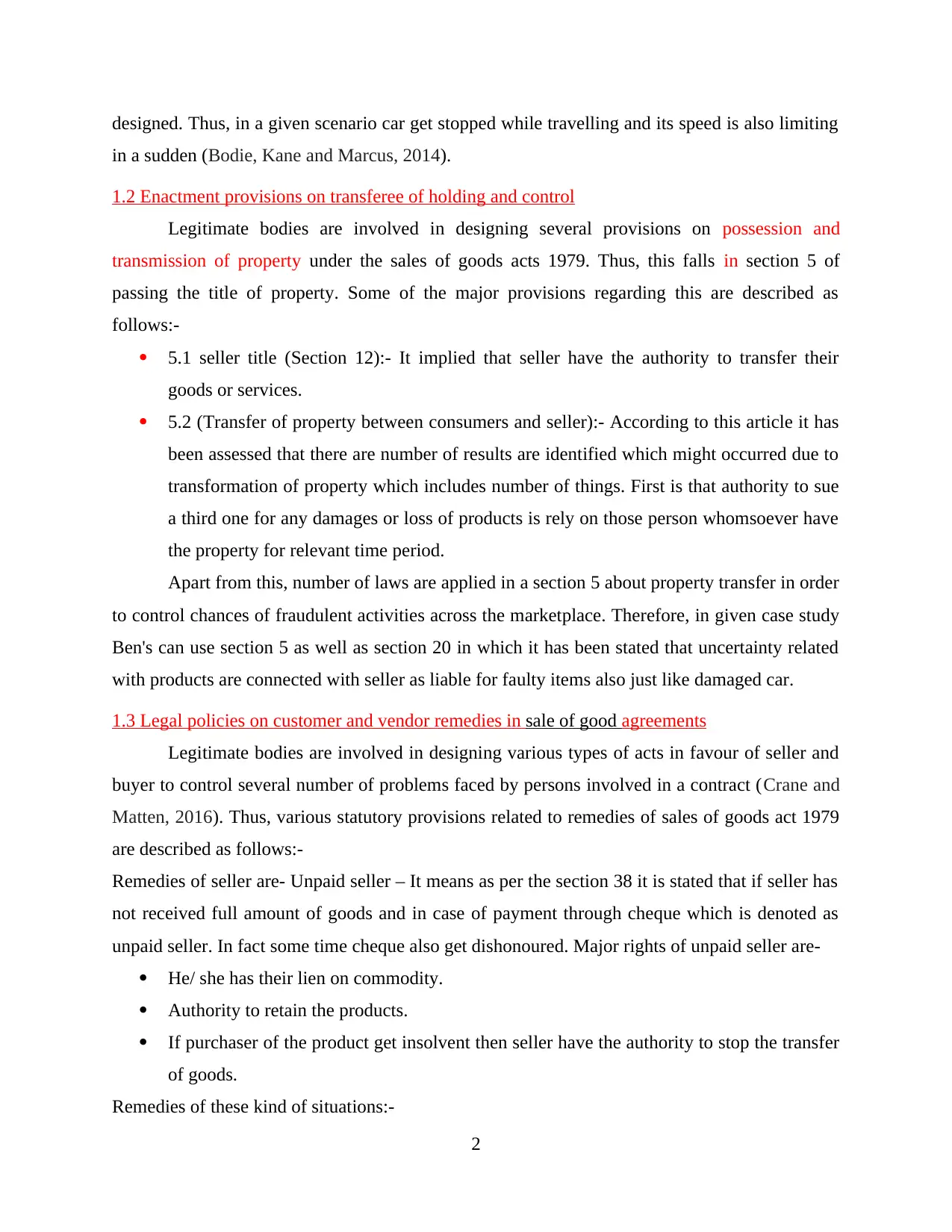
designed. Thus, in a given scenario car get stopped while travelling and its speed is also limiting
in a sudden (Bodie, Kane and Marcus, 2014).
1.2 Enactment provisions on transferee of holding and control
Legitimate bodies are involved in designing several provisions on possession and
transmission of property under the sales of goods acts 1979. Thus, this falls in section 5 of
passing the title of property. Some of the major provisions regarding this are described as
follows:-
5.1 seller title (Section 12):- It implied that seller have the authority to transfer their
goods or services.
5.2 (Transfer of property between consumers and seller):- According to this article it has
been assessed that there are number of results are identified which might occurred due to
transformation of property which includes number of things. First is that authority to sue
a third one for any damages or loss of products is rely on those person whomsoever have
the property for relevant time period.
Apart from this, number of laws are applied in a section 5 about property transfer in order
to control chances of fraudulent activities across the marketplace. Therefore, in given case study
Ben's can use section 5 as well as section 20 in which it has been stated that uncertainty related
with products are connected with seller as liable for faulty items also just like damaged car.
1.3 Legal policies on customer and vendor remedies in sale of good agreements
Legitimate bodies are involved in designing various types of acts in favour of seller and
buyer to control several number of problems faced by persons involved in a contract (Crane and
Matten, 2016). Thus, various statutory provisions related to remedies of sales of goods act 1979
are described as follows:-
Remedies of seller are- Unpaid seller – It means as per the section 38 it is stated that if seller has
not received full amount of goods and in case of payment through cheque which is denoted as
unpaid seller. In fact some time cheque also get dishonoured. Major rights of unpaid seller are-
He/ she has their lien on commodity.
Authority to retain the products.
If purchaser of the product get insolvent then seller have the authority to stop the transfer
of goods.
Remedies of these kind of situations:-
2
in a sudden (Bodie, Kane and Marcus, 2014).
1.2 Enactment provisions on transferee of holding and control
Legitimate bodies are involved in designing several provisions on possession and
transmission of property under the sales of goods acts 1979. Thus, this falls in section 5 of
passing the title of property. Some of the major provisions regarding this are described as
follows:-
5.1 seller title (Section 12):- It implied that seller have the authority to transfer their
goods or services.
5.2 (Transfer of property between consumers and seller):- According to this article it has
been assessed that there are number of results are identified which might occurred due to
transformation of property which includes number of things. First is that authority to sue
a third one for any damages or loss of products is rely on those person whomsoever have
the property for relevant time period.
Apart from this, number of laws are applied in a section 5 about property transfer in order
to control chances of fraudulent activities across the marketplace. Therefore, in given case study
Ben's can use section 5 as well as section 20 in which it has been stated that uncertainty related
with products are connected with seller as liable for faulty items also just like damaged car.
1.3 Legal policies on customer and vendor remedies in sale of good agreements
Legitimate bodies are involved in designing various types of acts in favour of seller and
buyer to control several number of problems faced by persons involved in a contract (Crane and
Matten, 2016). Thus, various statutory provisions related to remedies of sales of goods act 1979
are described as follows:-
Remedies of seller are- Unpaid seller – It means as per the section 38 it is stated that if seller has
not received full amount of goods and in case of payment through cheque which is denoted as
unpaid seller. In fact some time cheque also get dishonoured. Major rights of unpaid seller are-
He/ she has their lien on commodity.
Authority to retain the products.
If purchaser of the product get insolvent then seller have the authority to stop the transfer
of goods.
Remedies of these kind of situations:-
2
Secure Best Marks with AI Grader
Need help grading? Try our AI Grader for instant feedback on your assignments.
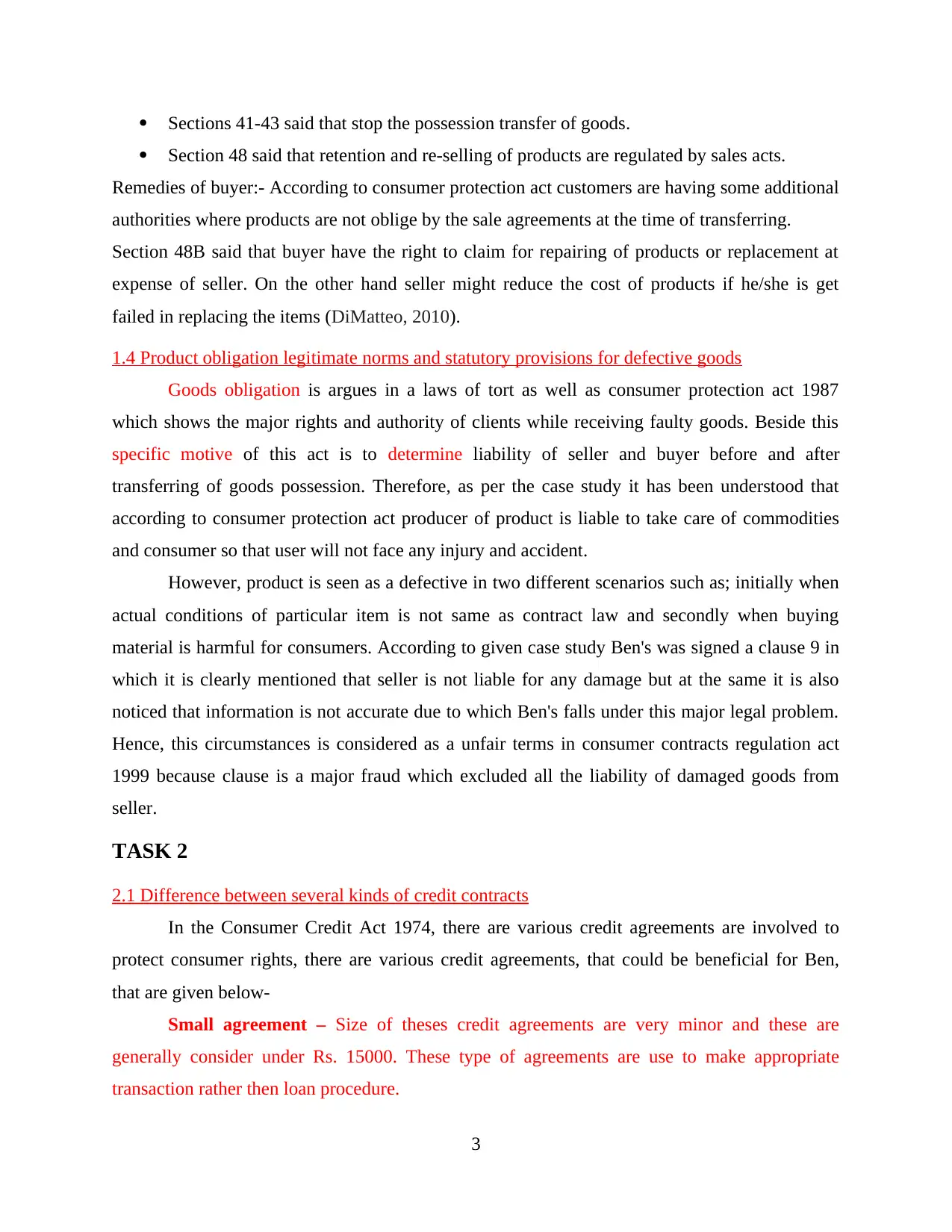
Sections 41-43 said that stop the possession transfer of goods.
Section 48 said that retention and re-selling of products are regulated by sales acts.
Remedies of buyer:- According to consumer protection act customers are having some additional
authorities where products are not oblige by the sale agreements at the time of transferring.
Section 48B said that buyer have the right to claim for repairing of products or replacement at
expense of seller. On the other hand seller might reduce the cost of products if he/she is get
failed in replacing the items (DiMatteo, 2010).
1.4 Product obligation legitimate norms and statutory provisions for defective goods
Goods obligation is argues in a laws of tort as well as consumer protection act 1987
which shows the major rights and authority of clients while receiving faulty goods. Beside this
specific motive of this act is to determine liability of seller and buyer before and after
transferring of goods possession. Therefore, as per the case study it has been understood that
according to consumer protection act producer of product is liable to take care of commodities
and consumer so that user will not face any injury and accident.
However, product is seen as a defective in two different scenarios such as; initially when
actual conditions of particular item is not same as contract law and secondly when buying
material is harmful for consumers. According to given case study Ben's was signed a clause 9 in
which it is clearly mentioned that seller is not liable for any damage but at the same it is also
noticed that information is not accurate due to which Ben's falls under this major legal problem.
Hence, this circumstances is considered as a unfair terms in consumer contracts regulation act
1999 because clause is a major fraud which excluded all the liability of damaged goods from
seller.
TASK 2
2.1 Difference between several kinds of credit contracts
In the Consumer Credit Act 1974, there are various credit agreements are involved to
protect consumer rights, there are various credit agreements, that could be beneficial for Ben,
that are given below-
Small agreement – Size of theses credit agreements are very minor and these are
generally consider under Rs. 15000. These type of agreements are use to make appropriate
transaction rather then loan procedure.
3
Section 48 said that retention and re-selling of products are regulated by sales acts.
Remedies of buyer:- According to consumer protection act customers are having some additional
authorities where products are not oblige by the sale agreements at the time of transferring.
Section 48B said that buyer have the right to claim for repairing of products or replacement at
expense of seller. On the other hand seller might reduce the cost of products if he/she is get
failed in replacing the items (DiMatteo, 2010).
1.4 Product obligation legitimate norms and statutory provisions for defective goods
Goods obligation is argues in a laws of tort as well as consumer protection act 1987
which shows the major rights and authority of clients while receiving faulty goods. Beside this
specific motive of this act is to determine liability of seller and buyer before and after
transferring of goods possession. Therefore, as per the case study it has been understood that
according to consumer protection act producer of product is liable to take care of commodities
and consumer so that user will not face any injury and accident.
However, product is seen as a defective in two different scenarios such as; initially when
actual conditions of particular item is not same as contract law and secondly when buying
material is harmful for consumers. According to given case study Ben's was signed a clause 9 in
which it is clearly mentioned that seller is not liable for any damage but at the same it is also
noticed that information is not accurate due to which Ben's falls under this major legal problem.
Hence, this circumstances is considered as a unfair terms in consumer contracts regulation act
1999 because clause is a major fraud which excluded all the liability of damaged goods from
seller.
TASK 2
2.1 Difference between several kinds of credit contracts
In the Consumer Credit Act 1974, there are various credit agreements are involved to
protect consumer rights, there are various credit agreements, that could be beneficial for Ben,
that are given below-
Small agreement – Size of theses credit agreements are very minor and these are
generally consider under Rs. 15000. These type of agreements are use to make appropriate
transaction rather then loan procedure.
3
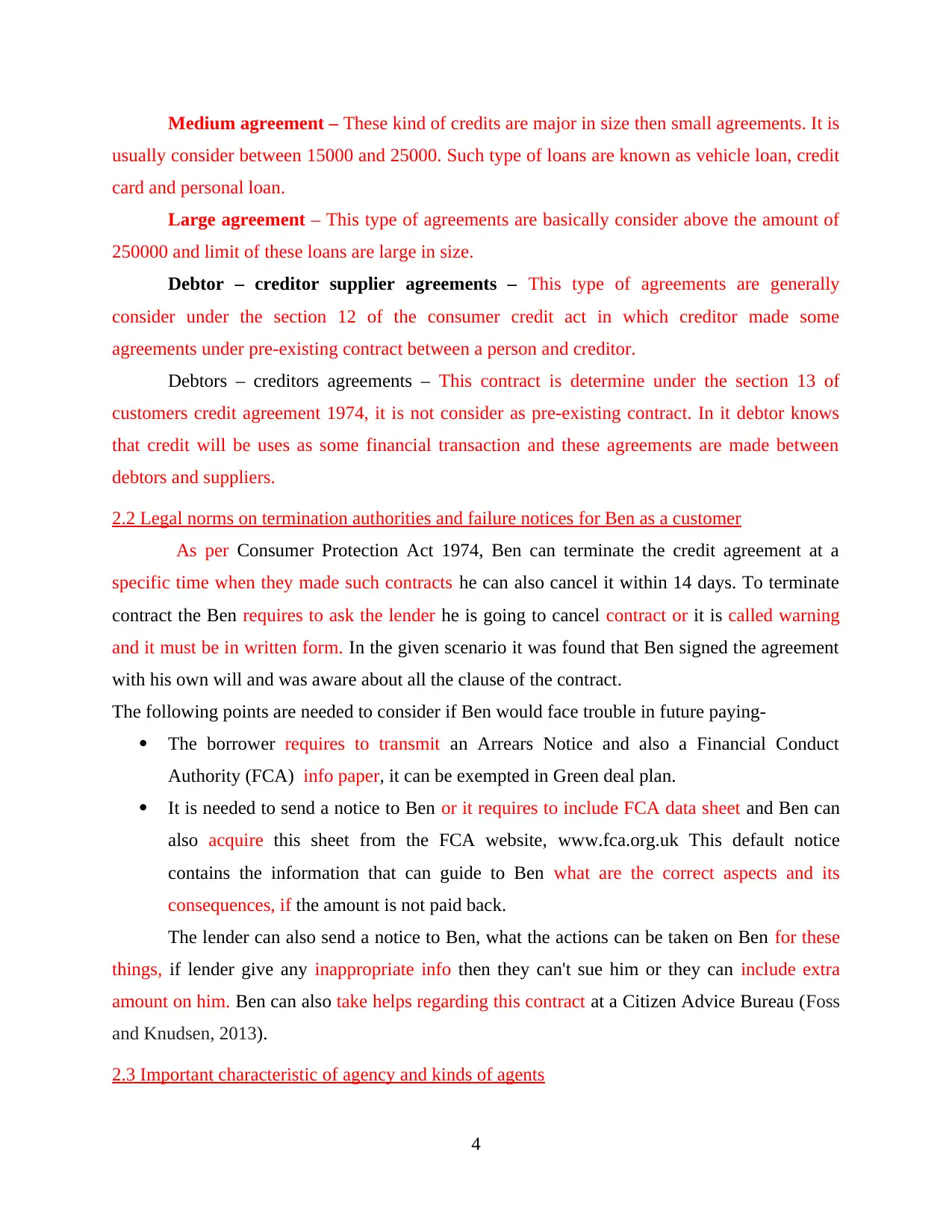
Medium agreement – These kind of credits are major in size then small agreements. It is
usually consider between 15000 and 25000. Such type of loans are known as vehicle loan, credit
card and personal loan.
Large agreement – This type of agreements are basically consider above the amount of
250000 and limit of these loans are large in size.
Debtor – creditor supplier agreements – This type of agreements are generally
consider under the section 12 of the consumer credit act in which creditor made some
agreements under pre-existing contract between a person and creditor.
Debtors – creditors agreements – This contract is determine under the section 13 of
customers credit agreement 1974, it is not consider as pre-existing contract. In it debtor knows
that credit will be uses as some financial transaction and these agreements are made between
debtors and suppliers.
2.2 Legal norms on termination authorities and failure notices for Ben as a customer
As per Consumer Protection Act 1974, Ben can terminate the credit agreement at a
specific time when they made such contracts he can also cancel it within 14 days. To terminate
contract the Ben requires to ask the lender he is going to cancel contract or it is called warning
and it must be in written form. In the given scenario it was found that Ben signed the agreement
with his own will and was aware about all the clause of the contract.
The following points are needed to consider if Ben would face trouble in future paying-
The borrower requires to transmit an Arrears Notice and also a Financial Conduct
Authority (FCA) info paper, it can be exempted in Green deal plan.
It is needed to send a notice to Ben or it requires to include FCA data sheet and Ben can
also acquire this sheet from the FCA website, www.fca.org.uk This default notice
contains the information that can guide to Ben what are the correct aspects and its
consequences, if the amount is not paid back.
The lender can also send a notice to Ben, what the actions can be taken on Ben for these
things, if lender give any inappropriate info then they can't sue him or they can include extra
amount on him. Ben can also take helps regarding this contract at a Citizen Advice Bureau (Foss
and Knudsen, 2013).
2.3 Important characteristic of agency and kinds of agents
4
usually consider between 15000 and 25000. Such type of loans are known as vehicle loan, credit
card and personal loan.
Large agreement – This type of agreements are basically consider above the amount of
250000 and limit of these loans are large in size.
Debtor – creditor supplier agreements – This type of agreements are generally
consider under the section 12 of the consumer credit act in which creditor made some
agreements under pre-existing contract between a person and creditor.
Debtors – creditors agreements – This contract is determine under the section 13 of
customers credit agreement 1974, it is not consider as pre-existing contract. In it debtor knows
that credit will be uses as some financial transaction and these agreements are made between
debtors and suppliers.
2.2 Legal norms on termination authorities and failure notices for Ben as a customer
As per Consumer Protection Act 1974, Ben can terminate the credit agreement at a
specific time when they made such contracts he can also cancel it within 14 days. To terminate
contract the Ben requires to ask the lender he is going to cancel contract or it is called warning
and it must be in written form. In the given scenario it was found that Ben signed the agreement
with his own will and was aware about all the clause of the contract.
The following points are needed to consider if Ben would face trouble in future paying-
The borrower requires to transmit an Arrears Notice and also a Financial Conduct
Authority (FCA) info paper, it can be exempted in Green deal plan.
It is needed to send a notice to Ben or it requires to include FCA data sheet and Ben can
also acquire this sheet from the FCA website, www.fca.org.uk This default notice
contains the information that can guide to Ben what are the correct aspects and its
consequences, if the amount is not paid back.
The lender can also send a notice to Ben, what the actions can be taken on Ben for these
things, if lender give any inappropriate info then they can't sue him or they can include extra
amount on him. Ben can also take helps regarding this contract at a Citizen Advice Bureau (Foss
and Knudsen, 2013).
2.3 Important characteristic of agency and kinds of agents
4
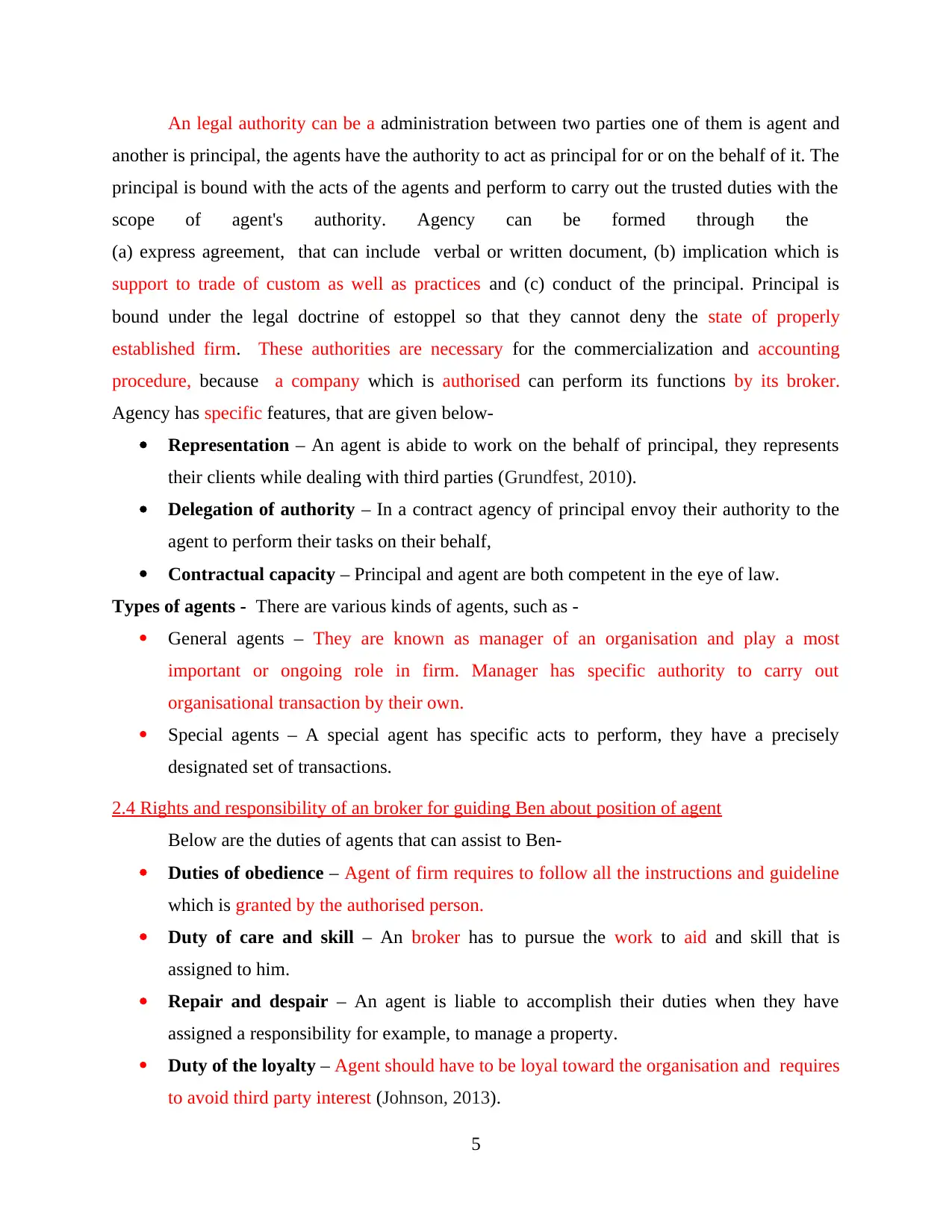
An legal authority can be a administration between two parties one of them is agent and
another is principal, the agents have the authority to act as principal for or on the behalf of it. The
principal is bound with the acts of the agents and perform to carry out the trusted duties with the
scope of agent's authority. Agency can be formed through the
(a) express agreement, that can include verbal or written document, (b) implication which is
support to trade of custom as well as practices and (c) conduct of the principal. Principal is
bound under the legal doctrine of estoppel so that they cannot deny the state of properly
established firm. These authorities are necessary for the commercialization and accounting
procedure, because a company which is authorised can perform its functions by its broker.
Agency has specific features, that are given below-
Representation – An agent is abide to work on the behalf of principal, they represents
their clients while dealing with third parties (Grundfest, 2010).
Delegation of authority – In a contract agency of principal envoy their authority to the
agent to perform their tasks on their behalf,
Contractual capacity – Principal and agent are both competent in the eye of law.
Types of agents - There are various kinds of agents, such as -
General agents – They are known as manager of an organisation and play a most
important or ongoing role in firm. Manager has specific authority to carry out
organisational transaction by their own.
Special agents – A special agent has specific acts to perform, they have a precisely
designated set of transactions.
2.4 Rights and responsibility of an broker for guiding Ben about position of agent
Below are the duties of agents that can assist to Ben-
Duties of obedience – Agent of firm requires to follow all the instructions and guideline
which is granted by the authorised person.
Duty of care and skill – An broker has to pursue the work to aid and skill that is
assigned to him.
Repair and despair – An agent is liable to accomplish their duties when they have
assigned a responsibility for example, to manage a property.
Duty of the loyalty – Agent should have to be loyal toward the organisation and requires
to avoid third party interest (Johnson, 2013).
5
another is principal, the agents have the authority to act as principal for or on the behalf of it. The
principal is bound with the acts of the agents and perform to carry out the trusted duties with the
scope of agent's authority. Agency can be formed through the
(a) express agreement, that can include verbal or written document, (b) implication which is
support to trade of custom as well as practices and (c) conduct of the principal. Principal is
bound under the legal doctrine of estoppel so that they cannot deny the state of properly
established firm. These authorities are necessary for the commercialization and accounting
procedure, because a company which is authorised can perform its functions by its broker.
Agency has specific features, that are given below-
Representation – An agent is abide to work on the behalf of principal, they represents
their clients while dealing with third parties (Grundfest, 2010).
Delegation of authority – In a contract agency of principal envoy their authority to the
agent to perform their tasks on their behalf,
Contractual capacity – Principal and agent are both competent in the eye of law.
Types of agents - There are various kinds of agents, such as -
General agents – They are known as manager of an organisation and play a most
important or ongoing role in firm. Manager has specific authority to carry out
organisational transaction by their own.
Special agents – A special agent has specific acts to perform, they have a precisely
designated set of transactions.
2.4 Rights and responsibility of an broker for guiding Ben about position of agent
Below are the duties of agents that can assist to Ben-
Duties of obedience – Agent of firm requires to follow all the instructions and guideline
which is granted by the authorised person.
Duty of care and skill – An broker has to pursue the work to aid and skill that is
assigned to him.
Repair and despair – An agent is liable to accomplish their duties when they have
assigned a responsibility for example, to manage a property.
Duty of the loyalty – Agent should have to be loyal toward the organisation and requires
to avoid third party interest (Johnson, 2013).
5
Paraphrase This Document
Need a fresh take? Get an instant paraphrase of this document with our AI Paraphraser
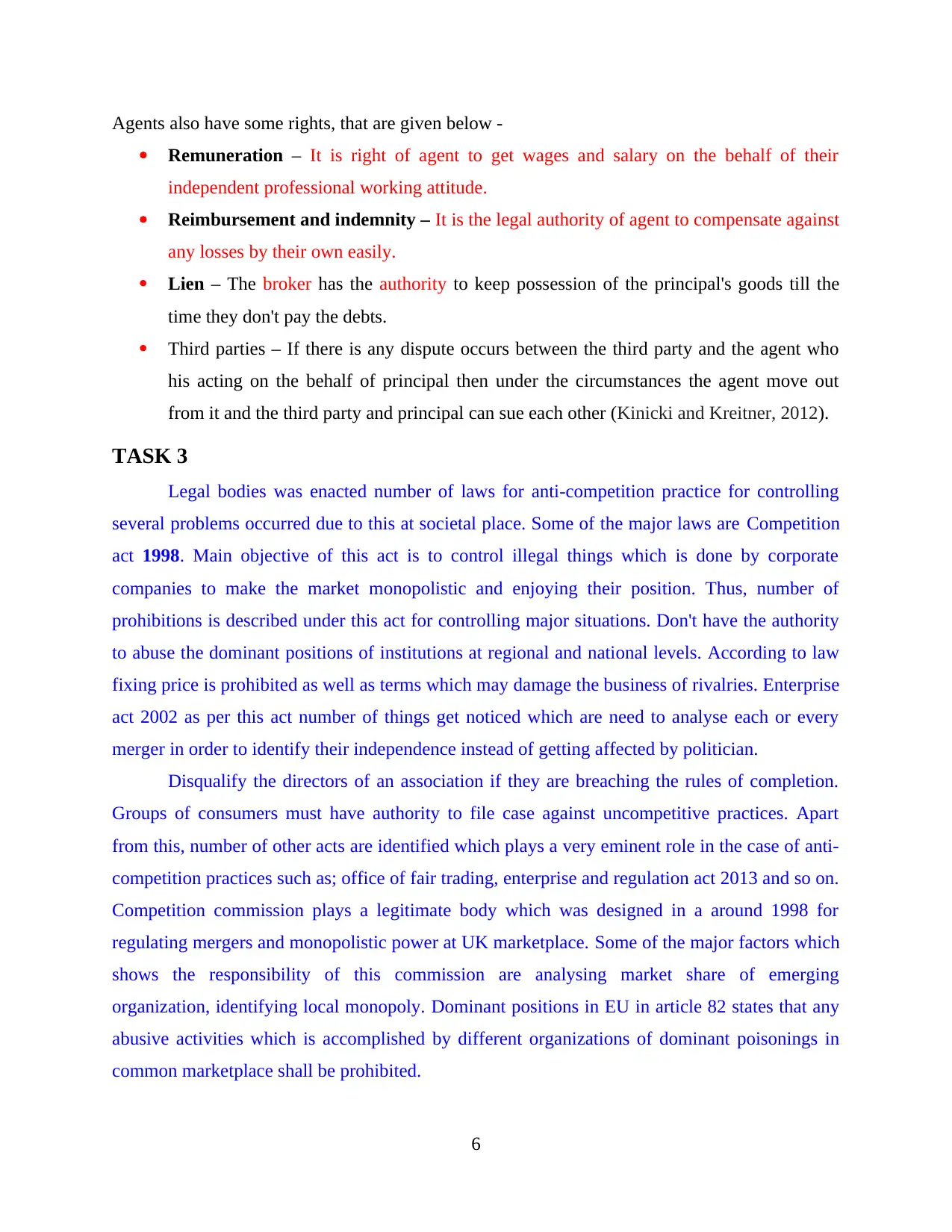
Agents also have some rights, that are given below -
Remuneration – It is right of agent to get wages and salary on the behalf of their
independent professional working attitude.
Reimbursement and indemnity – It is the legal authority of agent to compensate against
any losses by their own easily.
Lien – The broker has the authority to keep possession of the principal's goods till the
time they don't pay the debts.
Third parties – If there is any dispute occurs between the third party and the agent who
his acting on the behalf of principal then under the circumstances the agent move out
from it and the third party and principal can sue each other (Kinicki and Kreitner, 2012).
TASK 3
Legal bodies was enacted number of laws for anti-competition practice for controlling
several problems occurred due to this at societal place. Some of the major laws are Competition
act 1998. Main objective of this act is to control illegal things which is done by corporate
companies to make the market monopolistic and enjoying their position. Thus, number of
prohibitions is described under this act for controlling major situations. Don't have the authority
to abuse the dominant positions of institutions at regional and national levels. According to law
fixing price is prohibited as well as terms which may damage the business of rivalries. Enterprise
act 2002 as per this act number of things get noticed which are need to analyse each or every
merger in order to identify their independence instead of getting affected by politician.
Disqualify the directors of an association if they are breaching the rules of completion.
Groups of consumers must have authority to file case against uncompetitive practices. Apart
from this, number of other acts are identified which plays a very eminent role in the case of anti-
competition practices such as; office of fair trading, enterprise and regulation act 2013 and so on.
Competition commission plays a legitimate body which was designed in a around 1998 for
regulating mergers and monopolistic power at UK marketplace. Some of the major factors which
shows the responsibility of this commission are analysing market share of emerging
organization, identifying local monopoly. Dominant positions in EU in article 82 states that any
abusive activities which is accomplished by different organizations of dominant poisonings in
common marketplace shall be prohibited.
6
Remuneration – It is right of agent to get wages and salary on the behalf of their
independent professional working attitude.
Reimbursement and indemnity – It is the legal authority of agent to compensate against
any losses by their own easily.
Lien – The broker has the authority to keep possession of the principal's goods till the
time they don't pay the debts.
Third parties – If there is any dispute occurs between the third party and the agent who
his acting on the behalf of principal then under the circumstances the agent move out
from it and the third party and principal can sue each other (Kinicki and Kreitner, 2012).
TASK 3
Legal bodies was enacted number of laws for anti-competition practice for controlling
several problems occurred due to this at societal place. Some of the major laws are Competition
act 1998. Main objective of this act is to control illegal things which is done by corporate
companies to make the market monopolistic and enjoying their position. Thus, number of
prohibitions is described under this act for controlling major situations. Don't have the authority
to abuse the dominant positions of institutions at regional and national levels. According to law
fixing price is prohibited as well as terms which may damage the business of rivalries. Enterprise
act 2002 as per this act number of things get noticed which are need to analyse each or every
merger in order to identify their independence instead of getting affected by politician.
Disqualify the directors of an association if they are breaching the rules of completion.
Groups of consumers must have authority to file case against uncompetitive practices. Apart
from this, number of other acts are identified which plays a very eminent role in the case of anti-
competition practices such as; office of fair trading, enterprise and regulation act 2013 and so on.
Competition commission plays a legitimate body which was designed in a around 1998 for
regulating mergers and monopolistic power at UK marketplace. Some of the major factors which
shows the responsibility of this commission are analysing market share of emerging
organization, identifying local monopoly. Dominant positions in EU in article 82 states that any
abusive activities which is accomplished by different organizations of dominant poisonings in
common marketplace shall be prohibited.
6
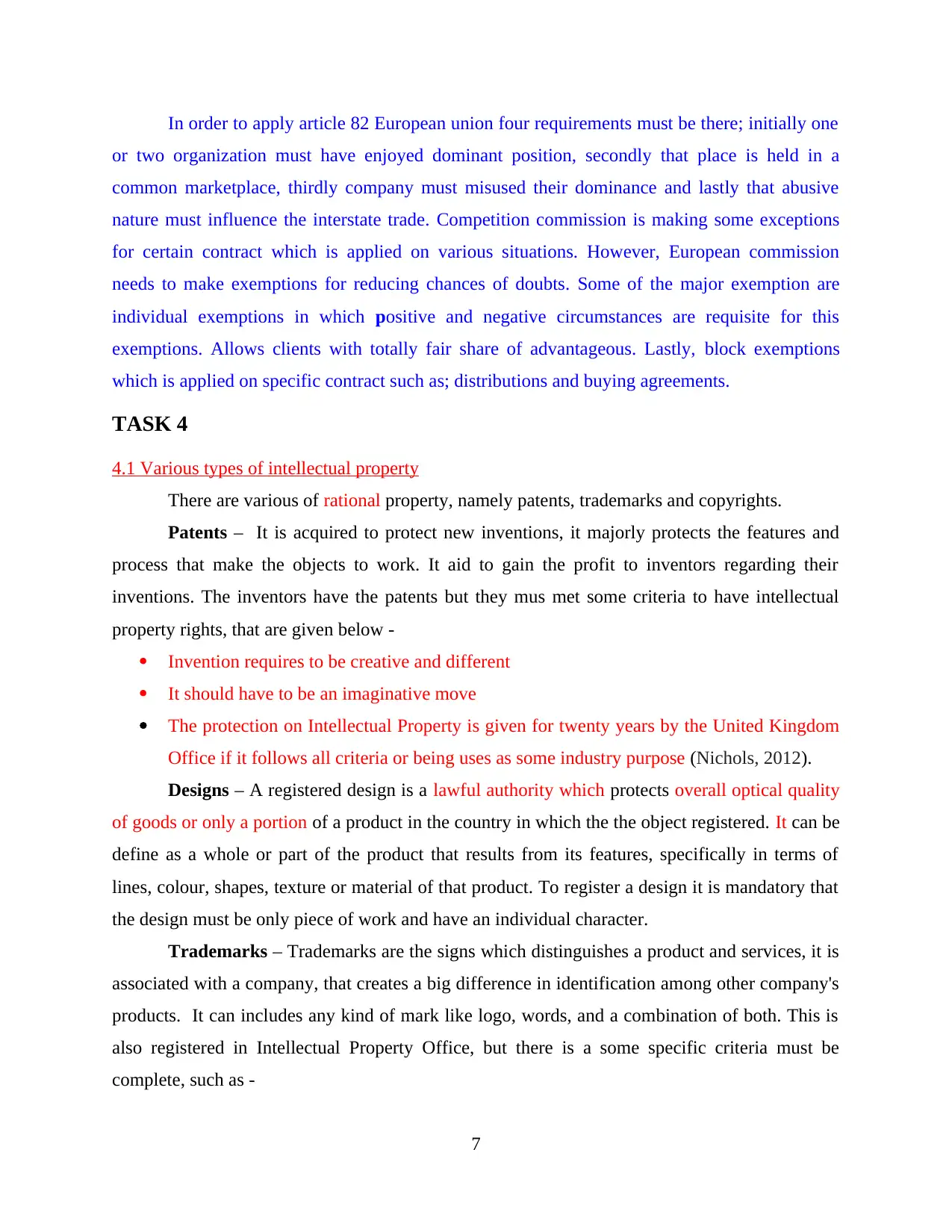
In order to apply article 82 European union four requirements must be there; initially one
or two organization must have enjoyed dominant position, secondly that place is held in a
common marketplace, thirdly company must misused their dominance and lastly that abusive
nature must influence the interstate trade. Competition commission is making some exceptions
for certain contract which is applied on various situations. However, European commission
needs to make exemptions for reducing chances of doubts. Some of the major exemption are
individual exemptions in which positive and negative circumstances are requisite for this
exemptions. Allows clients with totally fair share of advantageous. Lastly, block exemptions
which is applied on specific contract such as; distributions and buying agreements.
TASK 4
4.1 Various types of intellectual property
There are various of rational property, namely patents, trademarks and copyrights.
Patents – It is acquired to protect new inventions, it majorly protects the features and
process that make the objects to work. It aid to gain the profit to inventors regarding their
inventions. The inventors have the patents but they mus met some criteria to have intellectual
property rights, that are given below -
Invention requires to be creative and different
It should have to be an imaginative move
The protection on Intellectual Property is given for twenty years by the United Kingdom
Office if it follows all criteria or being uses as some industry purpose (Nichols, 2012).
Designs – A registered design is a lawful authority which protects overall optical quality
of goods or only a portion of a product in the country in which the the object registered. It can be
define as a whole or part of the product that results from its features, specifically in terms of
lines, colour, shapes, texture or material of that product. To register a design it is mandatory that
the design must be only piece of work and have an individual character.
Trademarks – Trademarks are the signs which distinguishes a product and services, it is
associated with a company, that creates a big difference in identification among other company's
products. It can includes any kind of mark like logo, words, and a combination of both. This is
also registered in Intellectual Property Office, but there is a some specific criteria must be
complete, such as -
7
or two organization must have enjoyed dominant position, secondly that place is held in a
common marketplace, thirdly company must misused their dominance and lastly that abusive
nature must influence the interstate trade. Competition commission is making some exceptions
for certain contract which is applied on various situations. However, European commission
needs to make exemptions for reducing chances of doubts. Some of the major exemption are
individual exemptions in which positive and negative circumstances are requisite for this
exemptions. Allows clients with totally fair share of advantageous. Lastly, block exemptions
which is applied on specific contract such as; distributions and buying agreements.
TASK 4
4.1 Various types of intellectual property
There are various of rational property, namely patents, trademarks and copyrights.
Patents – It is acquired to protect new inventions, it majorly protects the features and
process that make the objects to work. It aid to gain the profit to inventors regarding their
inventions. The inventors have the patents but they mus met some criteria to have intellectual
property rights, that are given below -
Invention requires to be creative and different
It should have to be an imaginative move
The protection on Intellectual Property is given for twenty years by the United Kingdom
Office if it follows all criteria or being uses as some industry purpose (Nichols, 2012).
Designs – A registered design is a lawful authority which protects overall optical quality
of goods or only a portion of a product in the country in which the the object registered. It can be
define as a whole or part of the product that results from its features, specifically in terms of
lines, colour, shapes, texture or material of that product. To register a design it is mandatory that
the design must be only piece of work and have an individual character.
Trademarks – Trademarks are the signs which distinguishes a product and services, it is
associated with a company, that creates a big difference in identification among other company's
products. It can includes any kind of mark like logo, words, and a combination of both. This is
also registered in Intellectual Property Office, but there is a some specific criteria must be
complete, such as -
7
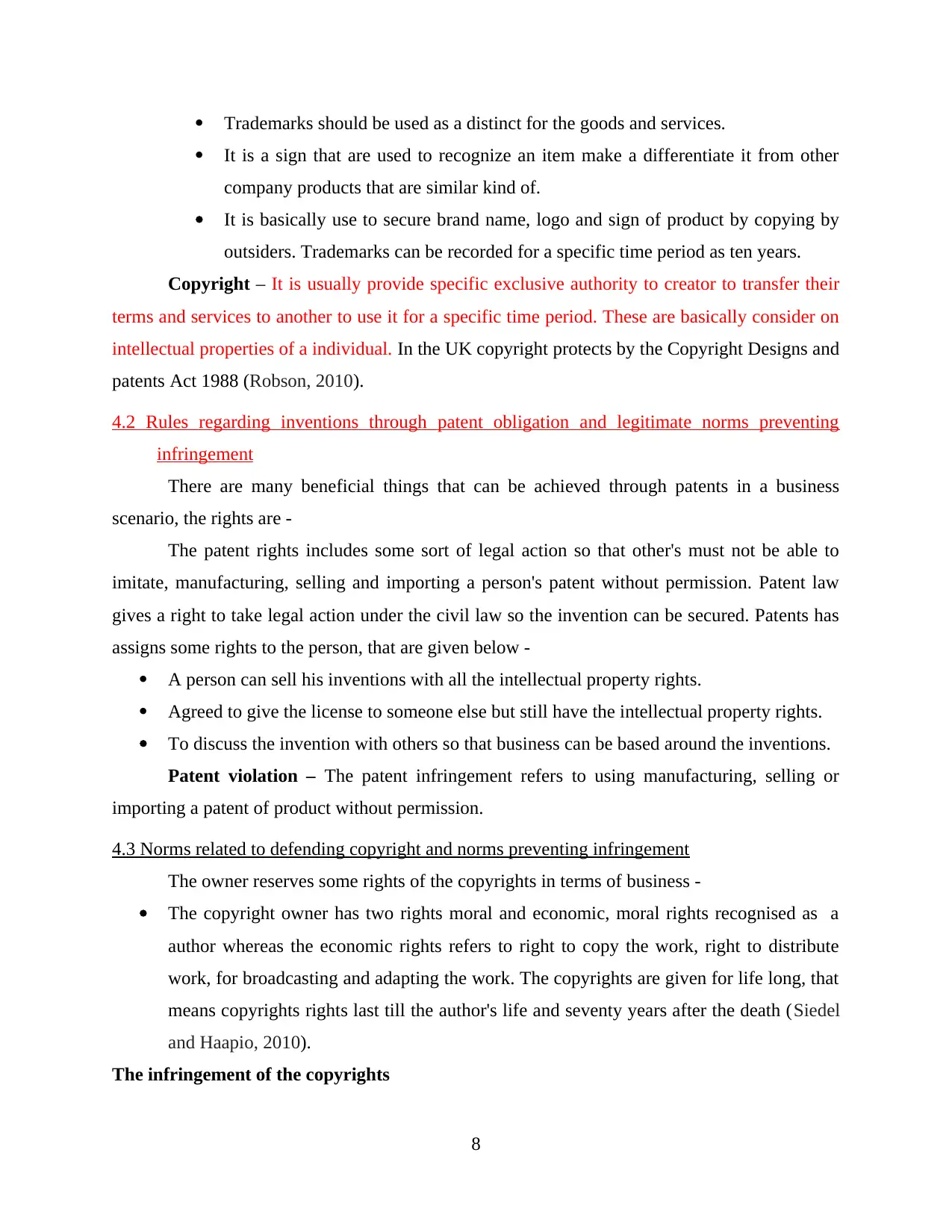
Trademarks should be used as a distinct for the goods and services.
It is a sign that are used to recognize an item make a differentiate it from other
company products that are similar kind of.
It is basically use to secure brand name, logo and sign of product by copying by
outsiders. Trademarks can be recorded for a specific time period as ten years.
Copyright – It is usually provide specific exclusive authority to creator to transfer their
terms and services to another to use it for a specific time period. These are basically consider on
intellectual properties of a individual. In the UK copyright protects by the Copyright Designs and
patents Act 1988 (Robson, 2010).
4.2 Rules regarding inventions through patent obligation and legitimate norms preventing
infringement
There are many beneficial things that can be achieved through patents in a business
scenario, the rights are -
The patent rights includes some sort of legal action so that other's must not be able to
imitate, manufacturing, selling and importing a person's patent without permission. Patent law
gives a right to take legal action under the civil law so the invention can be secured. Patents has
assigns some rights to the person, that are given below -
A person can sell his inventions with all the intellectual property rights.
Agreed to give the license to someone else but still have the intellectual property rights.
To discuss the invention with others so that business can be based around the inventions.
Patent violation – The patent infringement refers to using manufacturing, selling or
importing a patent of product without permission.
4.3 Norms related to defending copyright and norms preventing infringement
The owner reserves some rights of the copyrights in terms of business -
The copyright owner has two rights moral and economic, moral rights recognised as a
author whereas the economic rights refers to right to copy the work, right to distribute
work, for broadcasting and adapting the work. The copyrights are given for life long, that
means copyrights rights last till the author's life and seventy years after the death (Siedel
and Haapio, 2010).
The infringement of the copyrights
8
It is a sign that are used to recognize an item make a differentiate it from other
company products that are similar kind of.
It is basically use to secure brand name, logo and sign of product by copying by
outsiders. Trademarks can be recorded for a specific time period as ten years.
Copyright – It is usually provide specific exclusive authority to creator to transfer their
terms and services to another to use it for a specific time period. These are basically consider on
intellectual properties of a individual. In the UK copyright protects by the Copyright Designs and
patents Act 1988 (Robson, 2010).
4.2 Rules regarding inventions through patent obligation and legitimate norms preventing
infringement
There are many beneficial things that can be achieved through patents in a business
scenario, the rights are -
The patent rights includes some sort of legal action so that other's must not be able to
imitate, manufacturing, selling and importing a person's patent without permission. Patent law
gives a right to take legal action under the civil law so the invention can be secured. Patents has
assigns some rights to the person, that are given below -
A person can sell his inventions with all the intellectual property rights.
Agreed to give the license to someone else but still have the intellectual property rights.
To discuss the invention with others so that business can be based around the inventions.
Patent violation – The patent infringement refers to using manufacturing, selling or
importing a patent of product without permission.
4.3 Norms related to defending copyright and norms preventing infringement
The owner reserves some rights of the copyrights in terms of business -
The copyright owner has two rights moral and economic, moral rights recognised as a
author whereas the economic rights refers to right to copy the work, right to distribute
work, for broadcasting and adapting the work. The copyrights are given for life long, that
means copyrights rights last till the author's life and seventy years after the death (Siedel
and Haapio, 2010).
The infringement of the copyrights
8
Secure Best Marks with AI Grader
Need help grading? Try our AI Grader for instant feedback on your assignments.
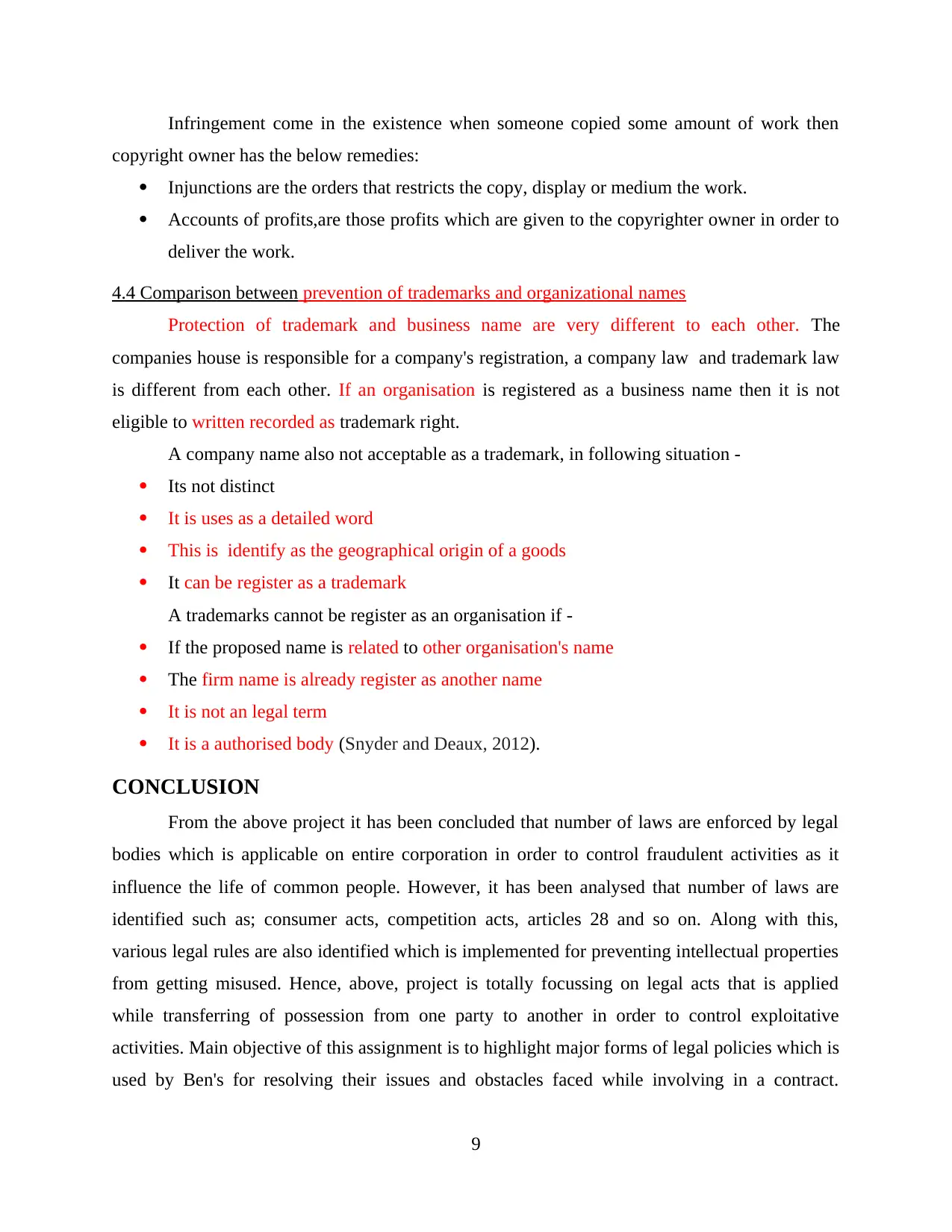
Infringement come in the existence when someone copied some amount of work then
copyright owner has the below remedies:
Injunctions are the orders that restricts the copy, display or medium the work.
Accounts of profits,are those profits which are given to the copyrighter owner in order to
deliver the work.
4.4 Comparison between prevention of trademarks and organizational names
Protection of trademark and business name are very different to each other. The
companies house is responsible for a company's registration, a company law and trademark law
is different from each other. If an organisation is registered as a business name then it is not
eligible to written recorded as trademark right.
A company name also not acceptable as a trademark, in following situation -
Its not distinct
It is uses as a detailed word
This is identify as the geographical origin of a goods
It can be register as a trademark
A trademarks cannot be register as an organisation if -
If the proposed name is related to other organisation's name
The firm name is already register as another name
It is not an legal term
It is a authorised body (Snyder and Deaux, 2012).
CONCLUSION
From the above project it has been concluded that number of laws are enforced by legal
bodies which is applicable on entire corporation in order to control fraudulent activities as it
influence the life of common people. However, it has been analysed that number of laws are
identified such as; consumer acts, competition acts, articles 28 and so on. Along with this,
various legal rules are also identified which is implemented for preventing intellectual properties
from getting misused. Hence, above, project is totally focussing on legal acts that is applied
while transferring of possession from one party to another in order to control exploitative
activities. Main objective of this assignment is to highlight major forms of legal policies which is
used by Ben's for resolving their issues and obstacles faced while involving in a contract.
9
copyright owner has the below remedies:
Injunctions are the orders that restricts the copy, display or medium the work.
Accounts of profits,are those profits which are given to the copyrighter owner in order to
deliver the work.
4.4 Comparison between prevention of trademarks and organizational names
Protection of trademark and business name are very different to each other. The
companies house is responsible for a company's registration, a company law and trademark law
is different from each other. If an organisation is registered as a business name then it is not
eligible to written recorded as trademark right.
A company name also not acceptable as a trademark, in following situation -
Its not distinct
It is uses as a detailed word
This is identify as the geographical origin of a goods
It can be register as a trademark
A trademarks cannot be register as an organisation if -
If the proposed name is related to other organisation's name
The firm name is already register as another name
It is not an legal term
It is a authorised body (Snyder and Deaux, 2012).
CONCLUSION
From the above project it has been concluded that number of laws are enforced by legal
bodies which is applicable on entire corporation in order to control fraudulent activities as it
influence the life of common people. However, it has been analysed that number of laws are
identified such as; consumer acts, competition acts, articles 28 and so on. Along with this,
various legal rules are also identified which is implemented for preventing intellectual properties
from getting misused. Hence, above, project is totally focussing on legal acts that is applied
while transferring of possession from one party to another in order to control exploitative
activities. Main objective of this assignment is to highlight major forms of legal policies which is
used by Ben's for resolving their issues and obstacles faced while involving in a contract.
9
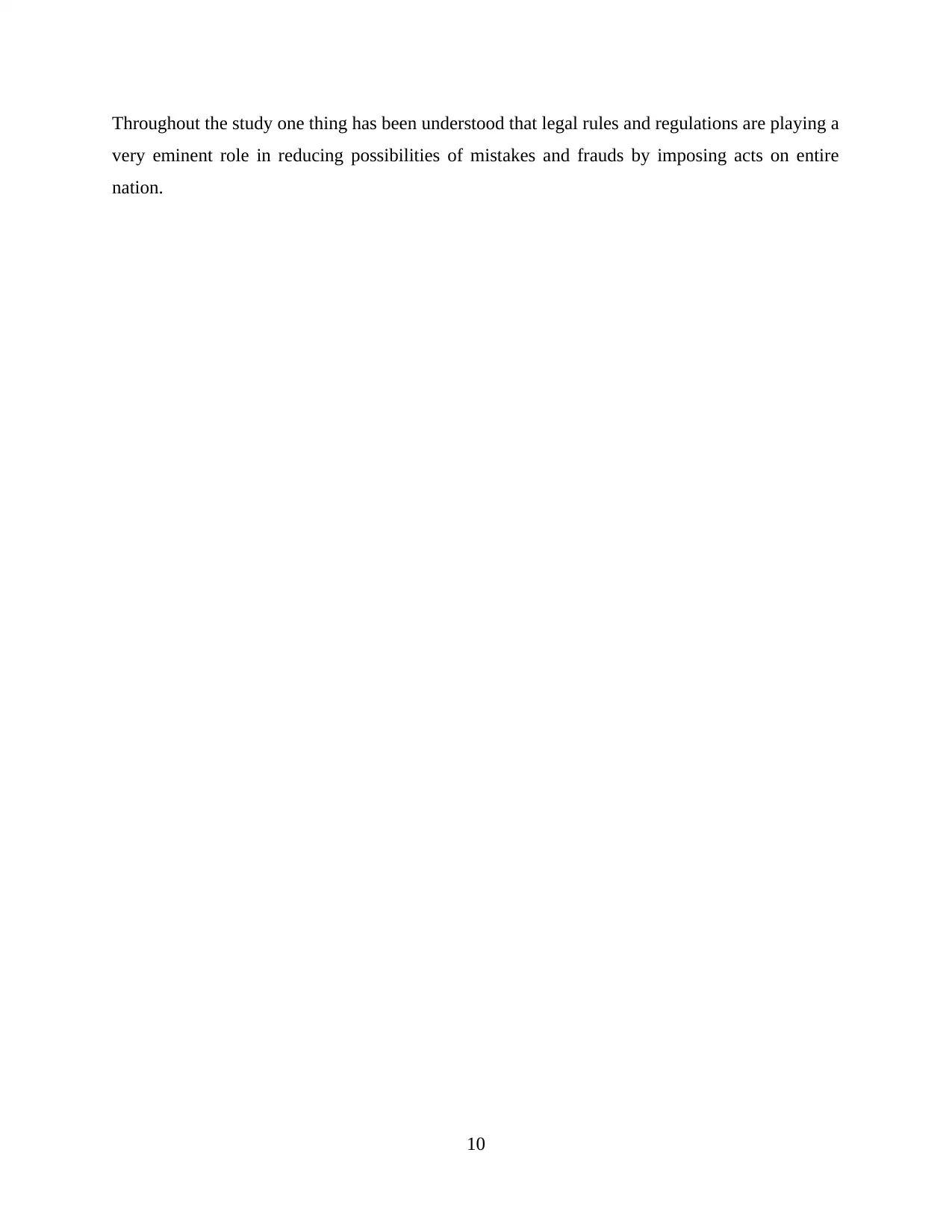
Throughout the study one thing has been understood that legal rules and regulations are playing a
very eminent role in reducing possibilities of mistakes and frauds by imposing acts on entire
nation.
10
very eminent role in reducing possibilities of mistakes and frauds by imposing acts on entire
nation.
10
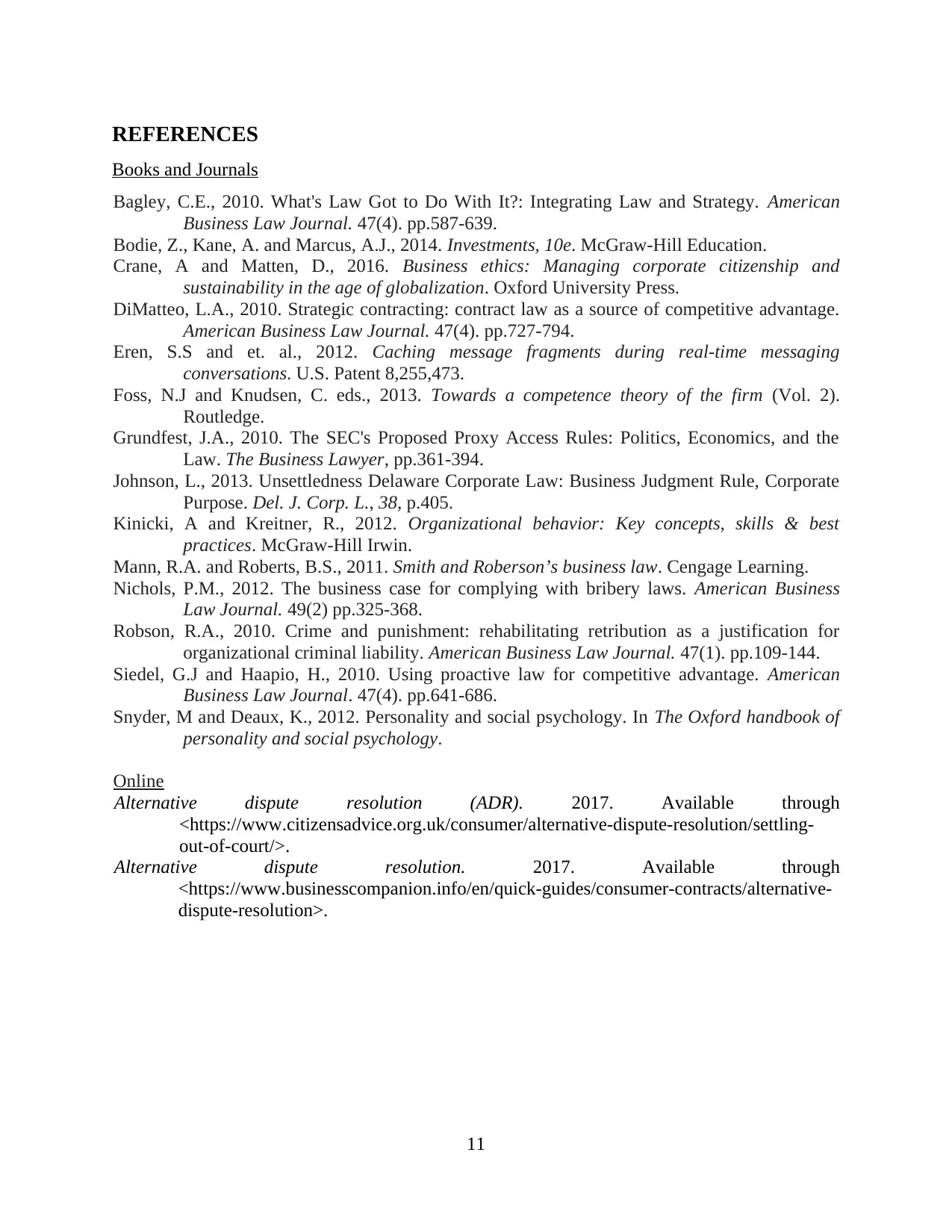
REFERENCES
Books and Journals
Bagley, C.E., 2010. What's Law Got to Do With It?: Integrating Law and Strategy. American
Business Law Journal. 47(4). pp.587-639.
Bodie, Z., Kane, A. and Marcus, A.J., 2014. Investments, 10e. McGraw-Hill Education.
Crane, A and Matten, D., 2016. Business ethics: Managing corporate citizenship and
sustainability in the age of globalization. Oxford University Press.
DiMatteo, L.A., 2010. Strategic contracting: contract law as a source of competitive advantage.
American Business Law Journal. 47(4). pp.727-794.
Eren, S.S and et. al., 2012. Caching message fragments during real-time messaging
conversations. U.S. Patent 8,255,473.
Foss, N.J and Knudsen, C. eds., 2013. Towards a competence theory of the firm (Vol. 2).
Routledge.
Grundfest, J.A., 2010. The SEC's Proposed Proxy Access Rules: Politics, Economics, and the
Law. The Business Lawyer, pp.361-394.
Johnson, L., 2013. Unsettledness Delaware Corporate Law: Business Judgment Rule, Corporate
Purpose. Del. J. Corp. L., 38, p.405.
Kinicki, A and Kreitner, R., 2012. Organizational behavior: Key concepts, skills & best
practices. McGraw-Hill Irwin.
Mann, R.A. and Roberts, B.S., 2011. Smith and Roberson’s business law. Cengage Learning.
Nichols, P.M., 2012. The business case for complying with bribery laws. American Business
Law Journal. 49(2) pp.325-368.
Robson, R.A., 2010. Crime and punishment: rehabilitating retribution as a justification for
organizational criminal liability. American Business Law Journal. 47(1). pp.109-144.
Siedel, G.J and Haapio, H., 2010. Using proactive law for competitive advantage. American
Business Law Journal. 47(4). pp.641-686.
Snyder, M and Deaux, K., 2012. Personality and social psychology. In The Oxford handbook of
personality and social psychology.
Online
Alternative dispute resolution (ADR). 2017. Available through
<https://www.citizensadvice.org.uk/consumer/alternative-dispute-resolution/settling-
out-of-court/>.
Alternative dispute resolution. 2017. Available through
<https://www.businesscompanion.info/en/quick-guides/consumer-contracts/alternative-
dispute-resolution>.
11
Books and Journals
Bagley, C.E., 2010. What's Law Got to Do With It?: Integrating Law and Strategy. American
Business Law Journal. 47(4). pp.587-639.
Bodie, Z., Kane, A. and Marcus, A.J., 2014. Investments, 10e. McGraw-Hill Education.
Crane, A and Matten, D., 2016. Business ethics: Managing corporate citizenship and
sustainability in the age of globalization. Oxford University Press.
DiMatteo, L.A., 2010. Strategic contracting: contract law as a source of competitive advantage.
American Business Law Journal. 47(4). pp.727-794.
Eren, S.S and et. al., 2012. Caching message fragments during real-time messaging
conversations. U.S. Patent 8,255,473.
Foss, N.J and Knudsen, C. eds., 2013. Towards a competence theory of the firm (Vol. 2).
Routledge.
Grundfest, J.A., 2010. The SEC's Proposed Proxy Access Rules: Politics, Economics, and the
Law. The Business Lawyer, pp.361-394.
Johnson, L., 2013. Unsettledness Delaware Corporate Law: Business Judgment Rule, Corporate
Purpose. Del. J. Corp. L., 38, p.405.
Kinicki, A and Kreitner, R., 2012. Organizational behavior: Key concepts, skills & best
practices. McGraw-Hill Irwin.
Mann, R.A. and Roberts, B.S., 2011. Smith and Roberson’s business law. Cengage Learning.
Nichols, P.M., 2012. The business case for complying with bribery laws. American Business
Law Journal. 49(2) pp.325-368.
Robson, R.A., 2010. Crime and punishment: rehabilitating retribution as a justification for
organizational criminal liability. American Business Law Journal. 47(1). pp.109-144.
Siedel, G.J and Haapio, H., 2010. Using proactive law for competitive advantage. American
Business Law Journal. 47(4). pp.641-686.
Snyder, M and Deaux, K., 2012. Personality and social psychology. In The Oxford handbook of
personality and social psychology.
Online
Alternative dispute resolution (ADR). 2017. Available through
<https://www.citizensadvice.org.uk/consumer/alternative-dispute-resolution/settling-
out-of-court/>.
Alternative dispute resolution. 2017. Available through
<https://www.businesscompanion.info/en/quick-guides/consumer-contracts/alternative-
dispute-resolution>.
11
Paraphrase This Document
Need a fresh take? Get an instant paraphrase of this document with our AI Paraphraser

12

13

14
1 out of 16
Related Documents
Your All-in-One AI-Powered Toolkit for Academic Success.
+13062052269
info@desklib.com
Available 24*7 on WhatsApp / Email
![[object Object]](/_next/static/media/star-bottom.7253800d.svg)
Unlock your academic potential
© 2024 | Zucol Services PVT LTD | All rights reserved.





